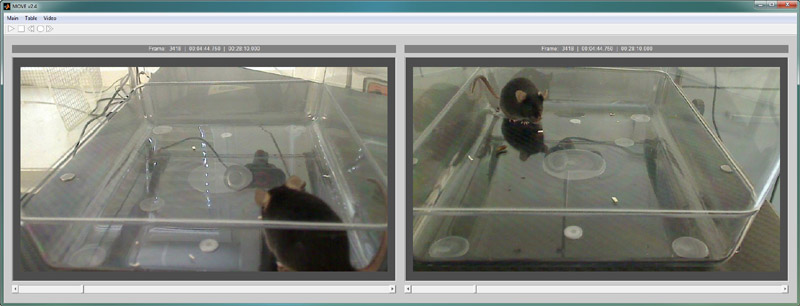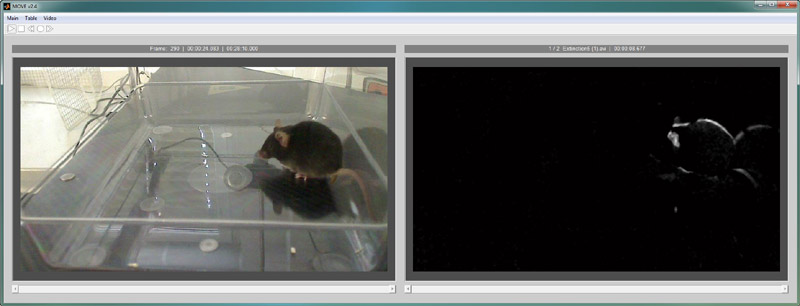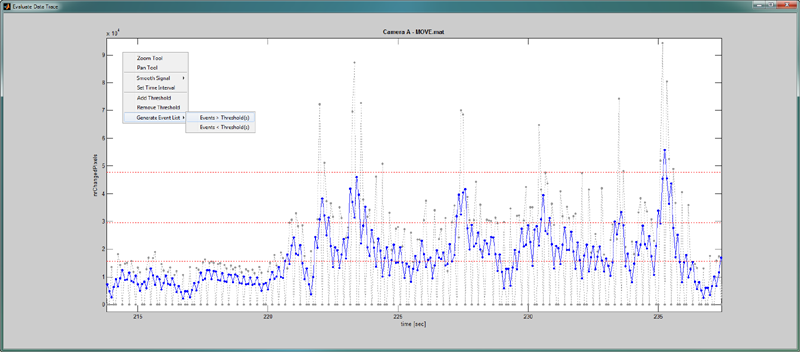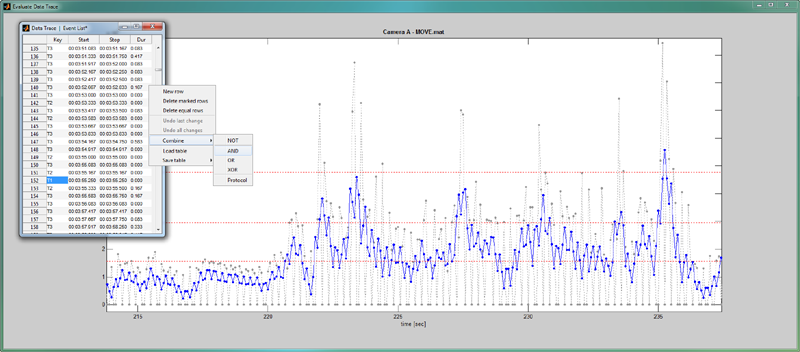MOVE is a comprehensive software suite that was developed from scientists for scientists in order to
improve, speed-up and standardize motion related data analysis.
So what does it make unique?
-
Recording
Using two oppositely located, horizontal cameras for the surveillance of a single object ensures a
close view on the object's head at any point in time and independent of its current orientation.
Consequently time intervals of slight head movements (e.g. sniffing) are much easier to distinguish
from freezing periods (Meuth et. al., 2013).
Therefore MOVE allows synchronized video recordings from two arbitrary video sources in parallel. By
supporting even cost-effective HD webcams connected via USB any given setup can be easily expanded
without endangering ongoing projects.
-
Motion analysis
Videos recorded by MOVE or any other software can be analyzed in MOVE via an unsupervised batch
process that quantifies the observed object's motion over time. The resulting motion trace can be
further subdivided into multiple motion levels representing e.g. immobility, sniffing, grooming and
exploration in order to generate a corresponding standard-compliant event list. Combining an event
list with the experiment's stimulation protocol automatically generates an overview that shows which
event / key / behavior was presented to which extent in each single phase of the protocol.
-
Multidimensionality
If two eyes see more than one it is logical that they can't see exactly the same. So how to combine
multiple data sources like e.g. two oppositely located video cameras (2D) or these two cameras plus
EEG and heart rate (4D)? For this purpose MOVE provides the Boolean algebra operators AND, OR, XOR
and NOT to be applied to any given pair of event lists.
Imagine each solid line in the given example graph represents a continuous freezing event reported by
two cameras A and B. Since A and B are not perfectly matching there must have been situations where
one camera has missed e.g. slight head movements during sniffing while the other one had a clear view
on that. In this case the final freezing event list should solely comprise those time periods when
both cameras stated freezing or in other words the solid lines overlap. This can be accomplished by
simply combining event list A and B with the AND operator (see "A AND B").
Let A now represent the harmonized freezing result of camera A and B of the previous example and B
represent phases of increased heart rate. Then the repeated application of the AND operator results
in a potentially more accurate freezing event list A AND B that already combines three different data
sources (3D) but still remains open to further expansion.
The last example should reveal the difference between the manual freezing score of an experienced
observer (A) and the semi-automated MOVE equivalent (B). By combining both event lists via the XOR
operator the resulting event list (see "A XOR B") comprises exactly those time periods when
solely one of the two event lists stated freezing but not both.
-
Keylogger
Key events in MOVE can be logged either in reference to the time scale of a playing video file or the
system clock in case e.g. the camera preview serves as video source. One can toggle on the fly between
the regular operation mode and the lock mode in which keys are automatically kept pressed until
another key gets pressed (starting a new event) or the same key gets pressed again (ending the current
event).
You are interested and want to give it a try? Then please follow the few registration steps
described
here.
PEAK is another in-house development
that could perfectly complement MOVE by providing a comprehensive mathematical analysis of the motion
trace.
References
Expression of freezing and fear-potentiated startle during sustained fear in mice.
Daldrup T, Remmes J, Lesting J, Gaburro S, Fendt M, Meuth P, Kloke V, Pape HC and Seidenbecher T.
Genes Brain Behav. 2015 Mar;14(3):281-91.
Standardizing the analysis of conditioned fear in rodents: a multidimensional software approach.
Meuth P, Gaburro S, Lesting J, Legler A, Herty M, Budde T, Meuth SG, Seidenbecher T, Lutz B and Pape HC.
Genes Brain Behav. 2013 Jul;12(5):583-92.
Screen shots
Dual camera view - Two oppositely located, horizontal cameras allow a clear view on the object's
head at any point in time.
Motion analysis - Motion gets quantified in terms of the total number
of pixels that significantly changed between the currently regarded video frame (left panel) and its predecessor.
These pixels are visualized as gray scale image (right panel) during the batch process.
Event list - A standard-compliant event list can be easily generated by dividing
(red dashed lines)
the given motion trace in different motion levels (representing e.g. immobility, sniffing, grooming and
exploration) and selecting the option "Generate Event List" from the right-click context menu.
Multidimensionality - The Boolean algebra operators AND, OR,
XOR and NOT allow the combination of an arbitrary number of event lists (data sources) in order to
reach the most accurate results possible.





